> People: including men, women, children, infants, saints
> Animals: including birds, horses, pigs
> Clothing: including crowns and shoes
> Anatomy: including heads, legs, hair
> Mythology:including dragons, the devil and ogres
> Objects:including walking sticks and keys
> Nature: including the sun, wheat and grapes
> Animals: including birds, horses, pigs
> Clothing: including crowns and shoes
> Anatomy: including heads, legs, hair
> Mythology:including dragons, the devil and ogres
> Objects:including walking sticks and keys
> Nature: including the sun, wheat and grapes
People
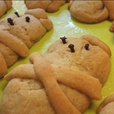
Lazarakia bread - Greece
Small, sweet spice breads made by Greek Orthodox Christians on Lazarus Saturday, the Saturday that begins Holy Week. They are eaten to celebrate the miracle of Jesus raising Lazarus from the dead. They are shaped like a man wrapped in a shroud - Saint Lazarus of Bethany - with cloves for eyes. They contain several sweet spices and are a fasting Lenten food, meaning that they usually do not contain any dairy products or eggs.
Small, sweet spice breads made by Greek Orthodox Christians on Lazarus Saturday, the Saturday that begins Holy Week. They are eaten to celebrate the miracle of Jesus raising Lazarus from the dead. They are shaped like a man wrapped in a shroud - Saint Lazarus of Bethany - with cloves for eyes. They contain several sweet spices and are a fasting Lenten food, meaning that they usually do not contain any dairy products or eggs.
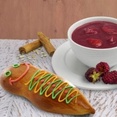
T'anta Wawa - Guaguas de Pan - Day of the Dead, Ecuador, Peru, .Colombia, .Argentina
This is a type of sweet roll shaped and decorated in the form of a small child or infant in a blanket, .generally made of wheat and sometimes containing a sweet filling. Made and eaten as part of ancestral rites on All Souls' Day and Nov 2nd for the Day of the Deceased - Dia de los Difuntos - but also as part of agricultural festivals, carnivals, and Christmas. In Ecuador, traditionally eaten with a purple corn and fruit drink called colada morada. Also called tantaguaguas, tantahuahua, wawas de pan, tantawawas and muñecas de pan.
This is a type of sweet roll shaped and decorated in the form of a small child or infant in a blanket, .generally made of wheat and sometimes containing a sweet filling. Made and eaten as part of ancestral rites on All Souls' Day and Nov 2nd for the Day of the Deceased - Dia de los Difuntos - but also as part of agricultural festivals, carnivals, and Christmas. In Ecuador, traditionally eaten with a purple corn and fruit drink called colada morada. Also called tantaguaguas, tantahuahua, wawas de pan, tantawawas and muñecas de pan.
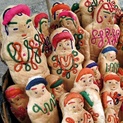
Pan de Muerto - Mexico
In some places bread used as an offering is the common bread of the area while in others like Oaxaca common sweet bread is decorated with little marzipan heads simulating a human body or in Puebla the regular bread is covered with red sugar for the adult altars and white sugar for children. Pan de Muerto is typically round with bone-like imagery on top but can also be shaped like skeletons, skulls, animals, angels or flowers and decorated with seeds, sugar or icing.
In some places bread used as an offering is the common bread of the area while in others like Oaxaca common sweet bread is decorated with little marzipan heads simulating a human body or in Puebla the regular bread is covered with red sugar for the adult altars and white sugar for children. Pan de Muerto is typically round with bone-like imagery on top but can also be shaped like skeletons, skulls, animals, angels or flowers and decorated with seeds, sugar or icing.
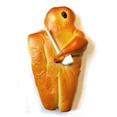
Stutenkerl or Weckmann - Germany, Austria, Switzerland, Luxemburg
Stuten is sweet leavened dough, Kerl is 'lad'.Available around Saint Nicholas' Day (Dec 6), Christmas and St Martin's day (Nov 11). Often contains raisins. Can feature a clay pipe which may be from the Reformation, making what was a Catholic bishop appear secular. Also called Kiepenkerl, Klaaskerl, Stutenmann, Hefekerl, Backsmann, Puhmann, Buckmann, Kaiten Jais, Hefekerl, Teigmännli, Elggermaa, Baselmann, Jean Bonhomme, Weggbopp. Mannele Boxemännchen (Luxembourg), Grittibänz/Grättimaa (Switzerland); Dambedei (see below.)
Stuten is sweet leavened dough, Kerl is 'lad'.Available around Saint Nicholas' Day (Dec 6), Christmas and St Martin's day (Nov 11). Often contains raisins. Can feature a clay pipe which may be from the Reformation, making what was a Catholic bishop appear secular. Also called Kiepenkerl, Klaaskerl, Stutenmann, Hefekerl, Backsmann, Puhmann, Buckmann, Kaiten Jais, Hefekerl, Teigmännli, Elggermaa, Baselmann, Jean Bonhomme, Weggbopp. Mannele Boxemännchen (Luxembourg), Grittibänz/Grättimaa (Switzerland); Dambedei (see below.)
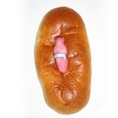
Cougnou - Belgium, also Coquille (Lille /Tournai), Cougnolle (Hainaut), (Cognolle (Mons), Quéniolle
Volaeren and Folarts: represents a cradle and can be accompaned by terracotta circles (ronds ) representing Jesus. Related to klaasskoeken in the Netherlands and parts of Belgium - smaller cakes, often without the rond, and so small that they are often sold by weight as opposed to by the piece; the clay figures are sometimes removed, particularly when mass produced, to the dismay of locals.
Volaeren and Folarts: represents a cradle and can be accompaned by terracotta circles (ronds ) representing Jesus. Related to klaasskoeken in the Netherlands and parts of Belgium - smaller cakes, often without the rond, and so small that they are often sold by weight as opposed to by the piece; the clay figures are sometimes removed, particularly when mass produced, to the dismay of locals.
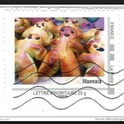
Mannala / Mannele (Alsace and Germany) - Jean Bonhomme (France)
Mannele (little men) are eaten year-round. At Christmas, in France, they represent the 3 children St Nicholas saved from the butcher. In Germany they are eaten as part of St Martin's Day (Sept 29.) where, in parts of the Rhine, they are also called Dambedei and eaten on 11 November where they commemorate how st Nicolas gave half of his coat to a beggar.
So valued are these little guys that they appeared on a French stamp (left.)
Mannele (little men) are eaten year-round. At Christmas, in France, they represent the 3 children St Nicholas saved from the butcher. In Germany they are eaten as part of St Martin's Day (Sept 29.) where, in parts of the Rhine, they are also called Dambedei and eaten on 11 November where they commemorate how st Nicolas gave half of his coat to a beggar.
So valued are these little guys that they appeared on a French stamp (left.)
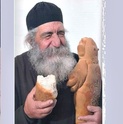
Bread oblations of St Antonios (Crete/Greece)
St Antonios was a healer of the sick. These anthropomorphic breads act as oblations (offerings) and are found in southwestern Crete, where the bread men sit in front of the sanctuary on St Antonios' feast day: Jan 17 in the village of Loutros in the temple named for the saint. After the service the breads are cut into small pieces and given to worshipers. Bread in the shapes of eyes, legs, arms and hearts are also prepared as ex-voto-like offerings.
St Antonios was a healer of the sick. These anthropomorphic breads act as oblations (offerings) and are found in southwestern Crete, where the bread men sit in front of the sanctuary on St Antonios' feast day: Jan 17 in the village of Loutros in the temple named for the saint. After the service the breads are cut into small pieces and given to worshipers. Bread in the shapes of eyes, legs, arms and hearts are also prepared as ex-voto-like offerings.
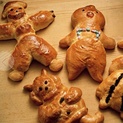
Harvest man / Lammas bread - Wicca
Lammas (harvest) is celebrated in the autumn or representing the full cycle of the harvest itself. Breads in the shape of men symbolise the 'spirit of the grain god in people through the eating of the bread.' In many traditions, a loaf or small loaves of special bread are baked in the shapes of men, to symbolise the god of the harvest.
Lammas (harvest) is celebrated in the autumn or representing the full cycle of the harvest itself. Breads in the shape of men symbolise the 'spirit of the grain god in people through the eating of the bread.' In many traditions, a loaf or small loaves of special bread are baked in the shapes of men, to symbolise the god of the harvest.
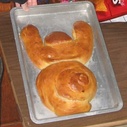
Ostara - Spring equinox bread - Wicca
This holiday is similar to Easter (in name as well as timing) but concentrates on the more basic focus of renewal.
This bread is baked in the form of a woman with unusually open arms, a symbol of fertility and rebirth.
This holiday is similar to Easter (in name as well as timing) but concentrates on the more basic focus of renewal.
This bread is baked in the form of a woman with unusually open arms, a symbol of fertility and rebirth.
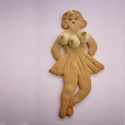
Pupazza Frascatana - Frascati, Italy
The doll-like biscuit with three breasts represents a midwife or nurse who looked after children of women engaged in the harvest. Two breasts are for milk, one for wine. Usually in a doll-like ('pupazza') form, with tutu. Now sometimes called Signorina Frascati. Origin unknown: some say the third breast was a fortunate mistake.
Available in her hometown of Frascati all year.
The doll-like biscuit with three breasts represents a midwife or nurse who looked after children of women engaged in the harvest. Two breasts are for milk, one for wine. Usually in a doll-like ('pupazza') form, with tutu. Now sometimes called Signorina Frascati. Origin unknown: some say the third breast was a fortunate mistake.
Available in her hometown of Frascati all year.
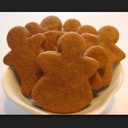
Harvest sheaf girl - Varnland, Sweden
Bread in the form of a little girl, made from the first grains of the harvest and representing the spirit of the grain, is supposedly still eaten by family members, similar to an edible corn dolly.
.
Bread in the form of a little girl, made from the first grains of the harvest and representing the spirit of the grain, is supposedly still eaten by family members, similar to an edible corn dolly.
.
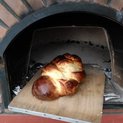
Alfilada: The Bishop - Basque regions (Spain) see Karapaixo
Like the Karapaixo, this bread is given by godparents to godchildren at Lent. Same sweetened bread, but in the shape of the Bishop, whose body is braided,
Symbol of renewal, and related to the Eucharist
Like the Karapaixo, this bread is given by godparents to godchildren at Lent. Same sweetened bread, but in the shape of the Bishop, whose body is braided,
Symbol of renewal, and related to the Eucharist
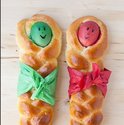
Croatian Easter Bread Dolls - primorski uskrsne bebe - Muñecos de pan de Pascua - Croatia, East Europe, South America
Eaten on the Saturday before Easter.
Traditionally from Croatia, but today even more popular in parts of South and Central America, which may be because they are so closely related to guaguas de pan and T'anta Wawa.
Eaten on the Saturday before Easter.
Traditionally from Croatia, but today even more popular in parts of South and Central America, which may be because they are so closely related to guaguas de pan and T'anta Wawa.
Animals
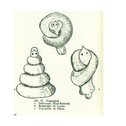
Jewish bird cake (Netherlands)
In his book Bread and pastry shapes and their significance in folklore JH Nannings describes the bird "that appeared on the table in German-speaking countries at the Jewish New Year." According to popular belief, the individual is assessed during this cycle. Spiral-baked loaves of bread with a bird on top symbolised the free flight of the bird whose "seemingly limitless height may rise as carrier and transmitter of prayer to the Almighty in heaven". (Dr. S. Weissenberg. Speise Gebäck und bei den Juden Südrussischen in ethno logical Beziehung).
In his book Bread and pastry shapes and their significance in folklore JH Nannings describes the bird "that appeared on the table in German-speaking countries at the Jewish New Year." According to popular belief, the individual is assessed during this cycle. Spiral-baked loaves of bread with a bird on top symbolised the free flight of the bird whose "seemingly limitless height may rise as carrier and transmitter of prayer to the Almighty in heaven". (Dr. S. Weissenberg. Speise Gebäck und bei den Juden Südrussischen in ethno logical Beziehung).
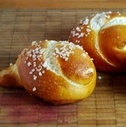
Laugenspatz - Germany (Ulm)
Little bird-shaped bread rolls are baked year round in honor of the legend that the inhabitants of Ulm once needed a particularly large beam for the construction of Ulm Minster, but could not get it through the city gate. As they were about to tear the gate down, they noticed a sparrow carrying a straw for its nest; which turned it from crosswise to lengthwise in its beak, an inspired feat of engineering.
Little bird-shaped bread rolls are baked year round in honor of the legend that the inhabitants of Ulm once needed a particularly large beam for the construction of Ulm Minster, but could not get it through the city gate. As they were about to tear the gate down, they noticed a sparrow carrying a straw for its nest; which turned it from crosswise to lengthwise in its beak, an inspired feat of engineering.
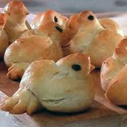
Bird bread for the March equinox (Belarus)
Saraki is a local holiday celebrated at the time of the March equinox to commemorate forty martyrs who suffered for the Christian faith, prolonging a pre-Christian custom of celebrating the return of forty birds and the arrival of spring. As part of the festivities, local women bake bread in the form of birds (every housewife has her own recipe for dough figurines, apparently), and the little birds are then thrown upwards into the sky.
Saraki is a local holiday celebrated at the time of the March equinox to commemorate forty martyrs who suffered for the Christian faith, prolonging a pre-Christian custom of celebrating the return of forty birds and the arrival of spring. As part of the festivities, local women bake bread in the form of birds (every housewife has her own recipe for dough figurines, apparently), and the little birds are then thrown upwards into the sky.
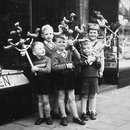
Paashaantje (Netherlands)
This Easter bread, carried on a stick and in the shape of a chick or rooster, is a symbol of the bread that Jesus broke at the last supper and also represents the rooster that "crowed after Peter three times to announce Jesus."
Bread chicks are placed on top of a "Palmesøndag" stick which is carried around in a procession on Palm Sunday.
This Easter bread, carried on a stick and in the shape of a chick or rooster, is a symbol of the bread that Jesus broke at the last supper and also represents the rooster that "crowed after Peter three times to announce Jesus."
Bread chicks are placed on top of a "Palmesøndag" stick which is carried around in a procession on Palm Sunday.
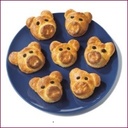
Neujahrsgebäck (New Year's bread) - Germany, Switzerland
These New Year breads are baked in the forms of trees, hares, deer and pigs, as well in pretzel and braid shapes, and are given to children as charms to protect against illness, misfortune and hunger. A portion of the leftover pastry was fed to livestock in order to protect them from harm. Pastry remnants were sometimes dried, crushed and spread like seeds in the fields, to ensure a good harvest. In parts of the Rhineland, girls received a braid and boys received a horse, symbols of fertility and luck.
These New Year breads are baked in the forms of trees, hares, deer and pigs, as well in pretzel and braid shapes, and are given to children as charms to protect against illness, misfortune and hunger. A portion of the leftover pastry was fed to livestock in order to protect them from harm. Pastry remnants were sometimes dried, crushed and spread like seeds in the fields, to ensure a good harvest. In parts of the Rhineland, girls received a braid and boys received a horse, symbols of fertility and luck.
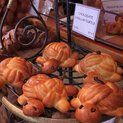
Challah turtle, gazelle, bird, etc (Morocco, North Africa, USA)
During the Jewish New Year, the ceremonial challah bread is baked in a round shape to represent the new year, as opposed to the traditional braided or long shape eaten at other times. In Morocco breads "emulate animals, like a swan, or often you'll have a head-like lion (of David) or gdi, which is like a gazelle."
With more Jews from North Africa emigrating to the USA, this tradition is now found in Portland Oregon, among other places.
During the Jewish New Year, the ceremonial challah bread is baked in a round shape to represent the new year, as opposed to the traditional braided or long shape eaten at other times. In Morocco breads "emulate animals, like a swan, or often you'll have a head-like lion (of David) or gdi, which is like a gazelle."
With more Jews from North Africa emigrating to the USA, this tradition is now found in Portland Oregon, among other places.
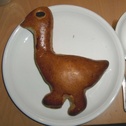
Martinsgans (St Martin's Day goose) - Germany
Martinmas - The Feast of Saint Martin of Tours/Martin le Miséricordieux, Nov 11 - celebrates the start of winter, the end of autumn and its wheat seeding, and the annual slaughter of fattened cattle ( 'Martinmas beef') and of geese. (related to American Thanksgiving.) St Martin was a Roman soldier who became a monk, is known for sharing his cloak with a beggar and interestingly is also sometimes credited with the introducing techniques of pruning grapes for wine production as well as the Chenin Blanc grape itself. In parts of Europe, real goose is eaten by those who can afford it and goose-shaped bread is eaten by by others.
Martinmas - The Feast of Saint Martin of Tours/Martin le Miséricordieux, Nov 11 - celebrates the start of winter, the end of autumn and its wheat seeding, and the annual slaughter of fattened cattle ( 'Martinmas beef') and of geese. (related to American Thanksgiving.) St Martin was a Roman soldier who became a monk, is known for sharing his cloak with a beggar and interestingly is also sometimes credited with the introducing techniques of pruning grapes for wine production as well as the Chenin Blanc grape itself. In parts of Europe, real goose is eaten by those who can afford it and goose-shaped bread is eaten by by others.
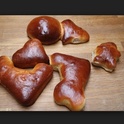
Klaaskoeken and Kloajspèrden - MainlyBeligium
Traditionally eaten in Western-Flanders, to remember Saint Nicholas and his horse and helpers who enter homes through the chimney on the 6th of December.
Used in sandwiches or with butter. The breads are formed in the shape of a horse ( ‘kloajspèrden’) or other animals such as ducks, or a man.
Traditionally eaten in Western-Flanders, to remember Saint Nicholas and his horse and helpers who enter homes through the chimney on the 6th of December.
Used in sandwiches or with butter. The breads are formed in the shape of a horse ( ‘kloajspèrden’) or other animals such as ducks, or a man.
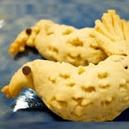
Uccellini di Saint'Antonio -Birds of Saint Anthony - Abruzzo (Italy)
In Abruzzo the saint is the protector of animals, stables, and preserver from fire hazards. His feast day is traditionally celebrated with the blessing of the stables and pigsties; one legend has God winning a battle with the devil and turning him into a pig.
The feast is on January 17 , but celebrations can last for the entire week leading up to it, with breads in animal shapes, notably birds.
In Abruzzo the saint is the protector of animals, stables, and preserver from fire hazards. His feast day is traditionally celebrated with the blessing of the stables and pigsties; one legend has God winning a battle with the devil and turning him into a pig.
The feast is on January 17 , but celebrations can last for the entire week leading up to it, with breads in animal shapes, notably birds.
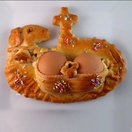
Cuddhura / Pani con l'Uovo / con l'Ova / (Italy, North Africa) - also called Titola
Sweet bread dough in the shape of doves, lambs, bells, crosses, and people ('pupi), holding one or more eggs and given at Easter and at other times, linked to the revival and fertility. Traditionally given on the Saturday before Easter. Shaped like a rooster for boys, a doll or basket for girls. Heart-shaped versions are given to 'all'innamorato.'
Sweet bread dough in the shape of doves, lambs, bells, crosses, and people ('pupi), holding one or more eggs and given at Easter and at other times, linked to the revival and fertility. Traditionally given on the Saturday before Easter. Shaped like a rooster for boys, a doll or basket for girls. Heart-shaped versions are given to 'all'innamorato.'
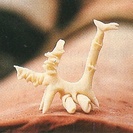
Cavadduzzi - Grashoppers: Feast of San Biagio Feb 3rd, Italy
This feast of San Biagio is one in the cycle of bread feasts (Sant' Antonio Abate, San Biagio (St. Blaise) and St. Joseph.) Cavadduzzi ("little grasshoppers") are small, intricate delicately shaped breads. They commemorate Calabria's liberation from an invasion of locusts in the sixteenth century, and anticipate future relief in their votive preparation and (mass) consumption each year
This feast of San Biagio is one in the cycle of bread feasts (Sant' Antonio Abate, San Biagio (St. Blaise) and St. Joseph.) Cavadduzzi ("little grasshoppers") are small, intricate delicately shaped breads. They commemorate Calabria's liberation from an invasion of locusts in the sixteenth century, and anticipate future relief in their votive preparation and (mass) consumption each year
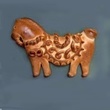
Horse-shaped bread - Netherlands
St Stephen is the patron saint of horses (and also wrens, fish, and livestock.) Horse-shaped breads are also part of Christmas celebrations due to the timing of feast day: the second day of Christmas.
In Germany, Poland, the Netherlands, Scandinavia & other parts of Europe, 26 December is celebrated as a second Christmas Day. Boxing day in the UK is closely allied to this tradition.
There is also a folk tale from Zevenbergen, first documented in 1705: a stolen horse could be returned to its rightful owner if all of its gear - saddles, stirrups and bridles - was placed in an oven after the bread was baked, and then straw would be added and the oven door firmly closed. www.bakkerijmuseum.nl
St Stephen is the patron saint of horses (and also wrens, fish, and livestock.) Horse-shaped breads are also part of Christmas celebrations due to the timing of feast day: the second day of Christmas.
In Germany, Poland, the Netherlands, Scandinavia & other parts of Europe, 26 December is celebrated as a second Christmas Day. Boxing day in the UK is closely allied to this tradition.
There is also a folk tale from Zevenbergen, first documented in 1705: a stolen horse could be returned to its rightful owner if all of its gear - saddles, stirrups and bridles - was placed in an oven after the bread was baked, and then straw would be added and the oven door firmly closed. www.bakkerijmuseum.nl
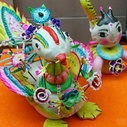
Mianhua or Miansu - China
A 4,000-year-old Chinese folk art. Dough figurines are also found in Tang dynasty (618-907) tombs as sacrificial offerings. Also in tables of offerings to gods at banquets.
Zhuge Liang, military strategist (220-280), is said to have calmed a rough crossing of the Han River with 49 dough heads stuffed with beef and horsemeat instead of sacrificed human heads. Today 75+-year-old Wu Chen Su and family are contemporary dough figurine artists still practicing the art.
A 4,000-year-old Chinese folk art. Dough figurines are also found in Tang dynasty (618-907) tombs as sacrificial offerings. Also in tables of offerings to gods at banquets.
Zhuge Liang, military strategist (220-280), is said to have calmed a rough crossing of the Han River with 49 dough heads stuffed with beef and horsemeat instead of sacrificed human heads. Today 75+-year-old Wu Chen Su and family are contemporary dough figurine artists still practicing the art.
Anatomy
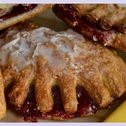
Martinshörnchen - Horse's hoof (Germany, Switzerland)
More of a pastry than a bread, something like a filled croissant and made to look like the hoof of St. Martin's horse, sometimes appearing as the half of a pretzel to symbolise the parting of his mantle. The shape can also symbolise the cloak that the St Martin (a Roman soldier turned monk) reputedly shared with a beggar. It's eaten as part of St Martin's Day festivities, Nov 10-11.
(related to: Stutenkerl/Weckmänner).
More of a pastry than a bread, something like a filled croissant and made to look like the hoof of St. Martin's horse, sometimes appearing as the half of a pretzel to symbolise the parting of his mantle. The shape can also symbolise the cloak that the St Martin (a Roman soldier turned monk) reputedly shared with a beggar. It's eaten as part of St Martin's Day festivities, Nov 10-11.
(related to: Stutenkerl/Weckmänner).
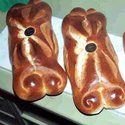
Duivekater - Netherlands
Eaten at Christmas and Easter.
In the shapes of bones - or vaguely human form - as a symbol of human sacrifice.
Also in Germany. Sometimes contain coins. Figures in 17th century Dutch paintings by Jan Steen, Rubens and others.
Related breads are also found in Roman burial grounds.
Eaten at Christmas and Easter.
In the shapes of bones - or vaguely human form - as a symbol of human sacrifice.
Also in Germany. Sometimes contain coins. Figures in 17th century Dutch paintings by Jan Steen, Rubens and others.
Related breads are also found in Roman burial grounds.
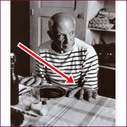
Main de Nice (Nice hand) - France
This specialty traditional bread was a common thing in and around Nice and is made in the form of a four-fingered hand, resembling the local fougasse. Sadly, it's disappeared from most local bakeries as customers opt for healthy, light breads that don't resemble four dead fat fingers. However, thanks to this photo by word famous photog Robert Doisneau showing Picasso himself posing with the bread and the star appeal of celeb chef Alain Ducasse who now offers his gourmet version of this 'forgotten gem' - we can hope for a minor revival.
This specialty traditional bread was a common thing in and around Nice and is made in the form of a four-fingered hand, resembling the local fougasse. Sadly, it's disappeared from most local bakeries as customers opt for healthy, light breads that don't resemble four dead fat fingers. However, thanks to this photo by word famous photog Robert Doisneau showing Picasso himself posing with the bread and the star appeal of celeb chef Alain Ducasse who now offers his gourmet version of this 'forgotten gem' - we can hope for a minor revival.
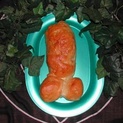
Beltane fertility bread (Wicca, pagan faiths)
This is a modern interpretation of the pagan spring festival of Beltane, with a focus on fertility, new livestock, the beginning of the agrarian year and new life all around.
Observed on May 1st in the northern hemisphere and Oct 31 - Nov 1 in the Southern Hemisphere.
This is a modern interpretation of the pagan spring festival of Beltane, with a focus on fertility, new livestock, the beginning of the agrarian year and new life all around.
Observed on May 1st in the northern hemisphere and Oct 31 - Nov 1 in the Southern Hemisphere.
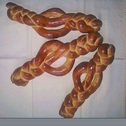
Seelenzopf (braid of hair) - Germany
Braided bread is common and often symbolic; this one represents an actual braid of hair. In Bavaria a women was expected to cut her long hair at the death of her husband.This bread - a Gebildbrot (one of a range of traditional festival or symbolic breads) - replaced the real hair. The bread is made of rye flour dough, often with honey and almonds on top. See Seelen (souls) bread
Braided bread is common and often symbolic; this one represents an actual braid of hair. In Bavaria a women was expected to cut her long hair at the death of her husband.This bread - a Gebildbrot (one of a range of traditional festival or symbolic breads) - replaced the real hair. The bread is made of rye flour dough, often with honey and almonds on top. See Seelen (souls) bread
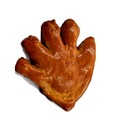
Storks' feet - Easter - Poland
Yeast buns in the shape of the five-fingered paws of a stork were made in southeastern Poland and Kurpie until the end of the nineteenth century, are much less common now, and are closely associated with the welcoming of spring and feast of the Annunciation of the Virgin Mary. A folk adage claimed that the stork accompanied the Annunciation. Related to Bird bread (Belarus)
Yeast buns in the shape of the five-fingered paws of a stork were made in southeastern Poland and Kurpie until the end of the nineteenth century, are much less common now, and are closely associated with the welcoming of spring and feast of the Annunciation of the Virgin Mary. A folk adage claimed that the stork accompanied the Annunciation. Related to Bird bread (Belarus)

Cassatella of St. Agatha - Catania (Italy) - also minuzze di virgine, minuzza di S Agata
Saint Agatha, the Patron Saint of Catania, a virgin who lived in the third of fourth century, rejected the amorous proposals of a Roman prefect and was tortured. Commemorative pastries are called Saint Agatha Breasts or cassatelle (cassa = trunk, casseta = little box?). At one time, baked by nuns. Available now year-round in the region of Catania. Originated as a pagan mother goddess-related form of worship. Also celebrated in Switzerland - Crown of Saint Agatha (True they are more cake than bread....)
Saint Agatha, the Patron Saint of Catania, a virgin who lived in the third of fourth century, rejected the amorous proposals of a Roman prefect and was tortured. Commemorative pastries are called Saint Agatha Breasts or cassatelle (cassa = trunk, casseta = little box?). At one time, baked by nuns. Available now year-round in the region of Catania. Originated as a pagan mother goddess-related form of worship. Also celebrated in Switzerland - Crown of Saint Agatha (True they are more cake than bread....)
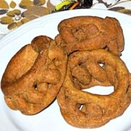
Cuddureddi - the throat: Feast of San Biagio Feb 3rd, Italy
One in the cycle of bread feasts (Sant' Antonio Abate, San Biagio (St. Blaise) and St. Joseph.) Cuddureddi ("little throats") are small, round (Eucharist-shaped) breads representing the throat. They are eaten by the saint's devotees as a spiritual guard against throat ailments, San Biagio's specialty.
One in the cycle of bread feasts (Sant' Antonio Abate, San Biagio (St. Blaise) and St. Joseph.) Cuddureddi ("little throats") are small, round (Eucharist-shaped) breads representing the throat. They are eaten by the saint's devotees as a spiritual guard against throat ailments, San Biagio's specialty.
Mythology
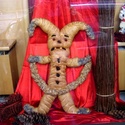
Krampus bread - Austria, Germany, Switzerland, France (Alsace and Lorraine)
The dark side of Farther Christmas is his evil hobgblin sidekick with many names (Knecht Ruprecht, Hans Trapp, Pere Foutard, Rupelz, Pezlnickel, Pelzmartin, Graale, Bullerklas, Bartel, Hans Muff, Bullerclas, Gumphinkeand and Zwarte Piet in the Netherlands, among others.) A solstice/winter pagan deity melded into Christmas mythology, Krampus reminds children to behave and be good, or risk a present-free holiday.
The dark side of Farther Christmas is his evil hobgblin sidekick with many names (Knecht Ruprecht, Hans Trapp, Pere Foutard, Rupelz, Pezlnickel, Pelzmartin, Graale, Bullerklas, Bartel, Hans Muff, Bullerclas, Gumphinkeand and Zwarte Piet in the Netherlands, among others.) A solstice/winter pagan deity melded into Christmas mythology, Krampus reminds children to behave and be good, or risk a present-free holiday.
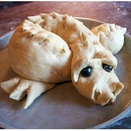
Dragon bread (UK, Europe)
September 29th is Michaelmas or St Michael's day marking the beginning of harvest and celebration of how St Michael's cast the devil from heaven. Because the devil himself landed on a patch of blackberry brambles, he returns yearly to spit on them, so no currants or blackberries must be picked after this date. St. Michael's bannocks (flat scones made of oats, barley and rye) are baked in the UK on a hot griddle and eaten with blackberry or currant preserves.
September 29th is Michaelmas or St Michael's day marking the beginning of harvest and celebration of how St Michael's cast the devil from heaven. Because the devil himself landed on a patch of blackberry brambles, he returns yearly to spit on them, so no currants or blackberries must be picked after this date. St. Michael's bannocks (flat scones made of oats, barley and rye) are baked in the UK on a hot griddle and eaten with blackberry or currant preserves.
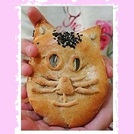
Seelen - the soul (poor souls) - Germany (Swabia) (All Souls Day)
A white bread, prepared from a very runny dough from spelt flour, yeast, water and salt. Traditionally formed into an elonged bread or little bread rolls and sprinkled with caraway and coarse salt.
Given as a symbolic offering to the poor souls in purgatory, to help ensure a rich harvest in the following year.
Today, sometimes made in shapes of animals and household objects.
A white bread, prepared from a very runny dough from spelt flour, yeast, water and salt. Traditionally formed into an elonged bread or little bread rolls and sprinkled with caraway and coarse salt.
Given as a symbolic offering to the poor souls in purgatory, to help ensure a rich harvest in the following year.
Today, sometimes made in shapes of animals and household objects.
Clothing
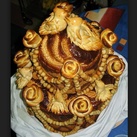
Korovai - Ukraine, Russia, Poland
The korova/korovai (crown) stems from a pagan belief in the magical properties of grain. For a wedding, an odd number of women (often 7 of them) make the bread in the home of the bride. Blessings go onto the bread when it goes into the oven. Two dough doves are placed on top in many regions. The top part, symbolizing the Moon, is divided and belongs to the marrying couple; Slices are given to family members.In eastern Ukraine, the mother of the bride receives a pair of shoes made out of dough, while the father is given an owl.
The korova/korovai (crown) stems from a pagan belief in the magical properties of grain. For a wedding, an odd number of women (often 7 of them) make the bread in the home of the bride. Blessings go onto the bread when it goes into the oven. Two dough doves are placed on top in many regions. The top part, symbolizing the Moon, is divided and belongs to the marrying couple; Slices are given to family members.In eastern Ukraine, the mother of the bride receives a pair of shoes made out of dough, while the father is given an owl.
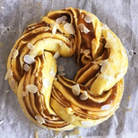
Crown of Saint Agatha (Switzerland, Italy, Europe)
Born in Sicily in 225 AD, Saint Agatha refused to marry an important politician who then had her tortured and killed. Shortly after, Mt Etna erupted and it was said that the lava flow could be stopped by invoking the name of the saint. On her saint's day, St Agatha's crown breads are brought to churches in parts of Switzerland (Shwryz province) to be blessed and to protect people from fire.
Also celebrated in Italy, See Cassatella of St. Agatha
Born in Sicily in 225 AD, Saint Agatha refused to marry an important politician who then had her tortured and killed. Shortly after, Mt Etna erupted and it was said that the lava flow could be stopped by invoking the name of the saint. On her saint's day, St Agatha's crown breads are brought to churches in parts of Switzerland (Shwryz province) to be blessed and to protect people from fire.
Also celebrated in Italy, See Cassatella of St. Agatha
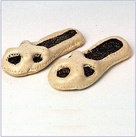
Fig-Filled Bread for St. Joseph Altar, Louisiana and other parts of the USA
St. Joseph's Day (19 March) commemorates relief from famine in medieval Sicily. Traditional altars feature cookies, cakes, lucky fava beans (which sustained the population) and ornate fig-filled breads in the shapes of crosses, a bishop's crozier, the communion chalice, and shapes associated with St Joseph himself: sandals, a staff, a ladder, tools such as a hammer and saw, nails, or a beard. (see Objects). The altar is broken up with a ceremony of costumed children pretending to look for shelter, then finding sustenance at the altar. Food and donations are then distributed to the poor.
St. Joseph's Day (19 March) commemorates relief from famine in medieval Sicily. Traditional altars feature cookies, cakes, lucky fava beans (which sustained the population) and ornate fig-filled breads in the shapes of crosses, a bishop's crozier, the communion chalice, and shapes associated with St Joseph himself: sandals, a staff, a ladder, tools such as a hammer and saw, nails, or a beard. (see Objects). The altar is broken up with a ceremony of costumed children pretending to look for shelter, then finding sustenance at the altar. Food and donations are then distributed to the poor.
Objects
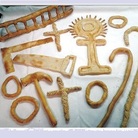
Hammer, ladder, saw, cane and other objects from St. Joseph Altar, Texas, USA
The tradition of a food-rich altar commemorating St Joseph's Day on 19 March is continued by Italian immigrants to America in New Orleans, parts of California and Chicago. (St Joseph reputedly brought rains to drought-starved medieval Sicily and altars feature bread in a variety of shapes. See Clothing.)
With the flight of significant numbers of New Orleans natives out of Louisiana following Hurricane Katrina, the tradition has been reborn in Texas where this photo was taken.
The tradition of a food-rich altar commemorating St Joseph's Day on 19 March is continued by Italian immigrants to America in New Orleans, parts of California and Chicago. (St Joseph reputedly brought rains to drought-starved medieval Sicily and altars feature bread in a variety of shapes. See Clothing.)
With the flight of significant numbers of New Orleans natives out of Louisiana following Hurricane Katrina, the tradition has been reborn in Texas where this photo was taken.
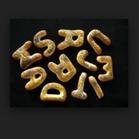
Letterbanket - Netherlands - and also in Iowa
In the Netherlands, families bake letter forms for Christmas and St Nicholas day. Each family member gets a bread or cake in the shape of the first letter of his/her first name. The letters are traditionally made of dough or puff pastry and marzipan.
Said to have encouraged literacy among women in the 1600's.
Often found today in the shape of the letter S, which is easier to make - especially outside of the Netherlands.
In the Netherlands, families bake letter forms for Christmas and St Nicholas day. Each family member gets a bread or cake in the shape of the first letter of his/her first name. The letters are traditionally made of dough or puff pastry and marzipan.
Said to have encouraged literacy among women in the 1600's.
Often found today in the shape of the letter S, which is easier to make - especially outside of the Netherlands.
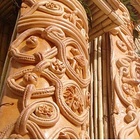
Arches made of bread - Archi di Pasqua - Italy ( Agrigento)
Large arches made of bread and including rosemary and dates are erected and remain up until after Easter, after which they are given to a dedicated museum: the Museo degli Archi. The tradition dates to the seventeenth century. The arches originally separated and marked the competition between two brotherhoods - the Madunnara and Signurara - who replaced violent in-fighting with competitions and sporting events. Food waste is seen as an 'act of mercy.' Video of the making of the arches here
Large arches made of bread and including rosemary and dates are erected and remain up until after Easter, after which they are given to a dedicated museum: the Museo degli Archi. The tradition dates to the seventeenth century. The arches originally separated and marked the competition between two brotherhoods - the Madunnara and Signurara - who replaced violent in-fighting with competitions and sporting events. Food waste is seen as an 'act of mercy.' Video of the making of the arches here
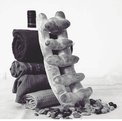
Ten commandments challah
The bread is a symbol for the giving of the ten commandments to Moses.
A traditional recipe that originated in eastern Europe, and is eaten during the holiday of Shavuot which commemorates the giving of the Torah to Moses on Mt Sinai, according Rabbi Dovid Meisels's Shavuos Secrets.
The bread is a symbol for the giving of the ten commandments to Moses.
A traditional recipe that originated in eastern Europe, and is eaten during the holiday of Shavuot which commemorates the giving of the Torah to Moses on Mt Sinai, according Rabbi Dovid Meisels's Shavuos Secrets.
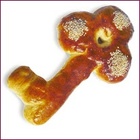
Shlissel or Schlissel Challah - Jewish tradition
From shlüssel (key, German) and challah (bread, Hebrew), the bread is baked on the Sabbath after Passover with a key inside. The loaf is often, but not always, in the shape of a key and is meant to favor increased wealth, and/or good or improved health. The custom is not originally Jewish. 'Paschal breads' with keys have been found throughout Europe from early Christian cultures where the key symbolised a cross. The Golden Bough. (Frazer, James George. London: Macmillan and Co., 1920) quotes 'In other parts of Esthonia [sic], again, the Christmas Boar [cake], as it is called, is baked of the first rye cut at harvest; it has a conical shape and a cross is impressed on it with a pig’s bone or a key, or three dints are made in it with a buckle or a piece of charcoal. It stands with a light beside it on the table all through the festival season.' Interesting to note that many Orthodox Jewish teachers believe that the bread is heretical because it acts as a 'segula' (charm) which is strictly not permitted.
From shlüssel (key, German) and challah (bread, Hebrew), the bread is baked on the Sabbath after Passover with a key inside. The loaf is often, but not always, in the shape of a key and is meant to favor increased wealth, and/or good or improved health. The custom is not originally Jewish. 'Paschal breads' with keys have been found throughout Europe from early Christian cultures where the key symbolised a cross. The Golden Bough. (Frazer, James George. London: Macmillan and Co., 1920) quotes 'In other parts of Esthonia [sic], again, the Christmas Boar [cake], as it is called, is baked of the first rye cut at harvest; it has a conical shape and a cross is impressed on it with a pig’s bone or a key, or three dints are made in it with a buckle or a piece of charcoal. It stands with a light beside it on the table all through the festival season.' Interesting to note that many Orthodox Jewish teachers believe that the bread is heretical because it acts as a 'segula' (charm) which is strictly not permitted.
Nature and objects
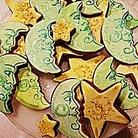
Moon and stars - Wicca
The moon and stars are invoked (and eaten) as part of a 'cakes and ale' ceremony at the close of Wicca rituals.
The moon and stars are invoked (and eaten) as part of a 'cakes and ale' ceremony at the close of Wicca rituals.
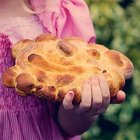
Winter solstice sun bread - USA, Europe, Wicca
Some homeschoolers place a real value on understanding of the changing seasons and associated rituals. A range of Lammas/ Michaelmas / harvest breads have been revived, re-invented and documented online.
Some homeschoolers place a real value on understanding of the changing seasons and associated rituals. A range of Lammas/ Michaelmas / harvest breads have been revived, re-invented and documented online.
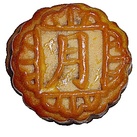
Moon cake - China, Malaysia, Taiwan, Viet Nam, other parts of Asia Mid-Autumn festival
Traditional moon cakes have one or more of these imprints: Chinese characters for longevity or harmony, the name of the bakery, the filling inside, the moon itself or the character indicating the moon, the goddess of the moon - Lady Chang'e, flowers, vines, or a rabbit (symbol of the moon.) Eaten as part of moon-watching at the Mid-Autumn Festival. Has a thin bread-like outer layer and contains a sweet filling, often with egg yolks or double egg yolk, a symbol of the moon and longevity. In the Ming dynasty contained secret message alerting people to the time and place of a revolt;therefore some consider mooncakes as precursors of fortune cookies.
Traditional moon cakes have one or more of these imprints: Chinese characters for longevity or harmony, the name of the bakery, the filling inside, the moon itself or the character indicating the moon, the goddess of the moon - Lady Chang'e, flowers, vines, or a rabbit (symbol of the moon.) Eaten as part of moon-watching at the Mid-Autumn Festival. Has a thin bread-like outer layer and contains a sweet filling, often with egg yolks or double egg yolk, a symbol of the moon and longevity. In the Ming dynasty contained secret message alerting people to the time and place of a revolt;therefore some consider mooncakes as precursors of fortune cookies.
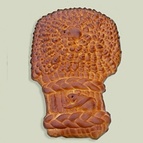
Harvest bread - Lammas bread UK, Europe (pagan Lughnasadh)
Lammas Day (Anglo-Saxon hlaf-mas, "loaf-mass") - the festival of the wheat harvest - is Aug 1 in the northern hemisphere / Feb 1 in the southern hemisphere. In Anglo Saxon England tradition, the first harvest loaf of the season was brought to church where it was blessed and could work magic. Today loaves are made to look like wheat sheaves and often feature a mouse or two. Until 1969 the day coincided with the feast of St Peter in Chains, and breads in chain form are sometimes also found at this time. Some Wiccans mark the holiday by baking a figure of the 'corn god' in bread, and then symbolically sacrificing and eating it.
Lammas Day (Anglo-Saxon hlaf-mas, "loaf-mass") - the festival of the wheat harvest - is Aug 1 in the northern hemisphere / Feb 1 in the southern hemisphere. In Anglo Saxon England tradition, the first harvest loaf of the season was brought to church where it was blessed and could work magic. Today loaves are made to look like wheat sheaves and often feature a mouse or two. Until 1969 the day coincided with the feast of St Peter in Chains, and breads in chain form are sometimes also found at this time. Some Wiccans mark the holiday by baking a figure of the 'corn god' in bread, and then symbolically sacrificing and eating it.
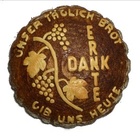
Erntedank (Harvest thanksgiving bread) - Germany
German's harvest festival is the first weekend of October. Shapes are formed on top of celebration breads but the breads themselves are round to represent the consistent rhythm of the seasons. Grapes, crosses and wheat are traditional symbols and the words 'Erntedank' (Harvest thanks) often appear, sometimes in form of a cross. (The words on the bread picture say 'Give us this day our daily bread.') There is some regret that this bread is rare 'in today's hurried age when much is thrown into the garbage' and the bread itself is for some a reminder of a happier, slower way of life.
German's harvest festival is the first weekend of October. Shapes are formed on top of celebration breads but the breads themselves are round to represent the consistent rhythm of the seasons. Grapes, crosses and wheat are traditional symbols and the words 'Erntedank' (Harvest thanks) often appear, sometimes in form of a cross. (The words on the bread picture say 'Give us this day our daily bread.') There is some regret that this bread is rare 'in today's hurried age when much is thrown into the garbage' and the bread itself is for some a reminder of a happier, slower way of life.
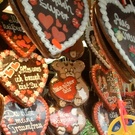
Lebkuchen, Pfefferkuchen Germany (Nuremberg)
More of a biscuit/cookie made with honey, spices and nuts. Leben (life), Leib (body), or Leibspeise (favorite food). Kuchen 'cake'. Honey has healing powers; honey-based cakes have been worn as a battle talisman and as protection against evil spirits. Prepared since the middle ages.
Local monks found additional use for extra communion wafers by increasing the diameter size and using them as the base for the dough required.
More of a biscuit/cookie made with honey, spices and nuts. Leben (life), Leib (body), or Leibspeise (favorite food). Kuchen 'cake'. Honey has healing powers; honey-based cakes have been worn as a battle talisman and as protection against evil spirits. Prepared since the middle ages.
Local monks found additional use for extra communion wafers by increasing the diameter size and using them as the base for the dough required.
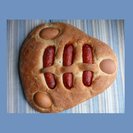
Karapaixo - Basque regions (Spain)
Given by godparents to godchildren at Lent. Made of eggs, chorizo and bread. Now sometimes includes chocolate and other sweets. Represents the godparents' 'annual income' to the godchild: A promise to support the child on an ongoing basis, and is part of a spring renewal tradition, also incorporating symbolism of the trinity. When the godchild is engaged to be married, the bread is no longer given as a present.
Given by godparents to godchildren at Lent. Made of eggs, chorizo and bread. Now sometimes includes chocolate and other sweets. Represents the godparents' 'annual income' to the godchild: A promise to support the child on an ongoing basis, and is part of a spring renewal tradition, also incorporating symbolism of the trinity. When the godchild is engaged to be married, the bread is no longer given as a present.
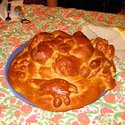
Seven Heaven / Siete Cielos challah Turkey, Greece, Morocco, North Africa
The festival commemorates the giving of the Torah on Mt Sinai, and the opening of the seven celestial spheres. In Sephardic tradition, the following symbols appear on the bread: the 2 tablets given to Moses, a ladder, a fish, a dove or a bird, a 'hamsa' (the North African symbol of the 'Hand of Fatima' or Hand of Miriam), and Moses' copper serpent.
A central orb represents Mount Sinai.
The festival commemorates the giving of the Torah on Mt Sinai, and the opening of the seven celestial spheres. In Sephardic tradition, the following symbols appear on the bread: the 2 tablets given to Moses, a ladder, a fish, a dove or a bird, a 'hamsa' (the North African symbol of the 'Hand of Fatima' or Hand of Miriam), and Moses' copper serpent.
A central orb represents Mount Sinai.
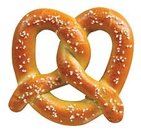
Pretzels
Permitted during Lent from the 17th century. Cheap to make, distributed to the poor in Northern Europe. A symbol for undying love ("tying the knot.") and religious love. Three holes represent the Holy Trinity. From Germany, found throughout medieval Europe, with symbolic usage in Italy. Also thought to have replaced the arm ring buried with the dead in Nordic and Viking cultures, as a symbol of remembrance (The Sensible Cook: Dutch Foodways in the Old and the New World, Peter G. Rose - 1998)
Permitted during Lent from the 17th century. Cheap to make, distributed to the poor in Northern Europe. A symbol for undying love ("tying the knot.") and religious love. Three holes represent the Holy Trinity. From Germany, found throughout medieval Europe, with symbolic usage in Italy. Also thought to have replaced the arm ring buried with the dead in Nordic and Viking cultures, as a symbol of remembrance (The Sensible Cook: Dutch Foodways in the Old and the New World, Peter G. Rose - 1998)